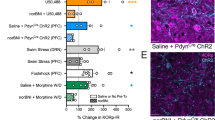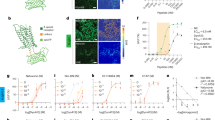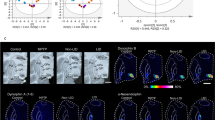Abstract
Dynorphin is a 17 amino acid opioid peptide which was originally isolated and characterized from pig neurohypophysis and gut extracts1–3. It contains a leucine-enkephalin (Leu-enkephalin) sequence at the amino terminus and has an unusually potent in vitro opiate activity in the guinea pig ileum longitudinal muscle/myenteric plexus preparation1–4. Immunohistochemical studies have shown that perikarya, nerve fibres and terminals widely distributed throughout the central nervous system5,6 are immunoreactive for both dynorphin1–17 and α-neo-endorphin6,7, another Leu-enkephalin-containing opioid peptide which is structurally related to dynorphin (Fig. 1) and was isolated from hypothalamus8. But although the regional distributions of α-neo-endorphin and dynorphin1–17 in rat brain, as measured by radioimmunoassay (RIA), are similar, the molar ratio of the two peptides seems to vary greatly from region to region, with α-neo-endorphin being present in much higher concentrations than dynorphini1–17 9–11. We now report that dynorphin1–8, an amino-terminal fragment (Fig. 1), which has only ∼3% of the opioid potency of dynorphin1–17, (ref. 4), is present in up to 10-fold higher concentrations in brain than dynorphhi1–17 immunoreactivity. We further show that dynorphin1–8, but not dynorphin1–17, occurs in approximately equimolar concentrations with α-neo-endorphin in all brain regions examined, suggesting a close biosynthetic relationship between α-neo-endorphin and dynorphin1–8.
Similar content being viewed by others
Article PDF
References
Goldstein, A., Tachibana, S., Lowney, L. I., Hunkapillar, M. & Hood, L. Proc. natn. Acad. Sci. U.S.A. 76, 6666–6670 (1979).
Goldstein, A., Fischli, W., Lowney, L., Hunkapillar, M. & Hood, L. Proc. natn. Acad. Sci. U.S.A. 78, 7219–7223 (1981).
Tachibana, S., Araki, K., Ohya, S. & Yoshida, S. Nature 295, 339–340 (1982).
Chavkin, C. & Goldstein, A. Proc. natn. Acad. Sci. U.S.A. 78, 6543–6547 (1981).
Watson, S. J., Akil, H., Ghazarossian, V. E. & Goldstein, A. Proc. natn. Acad. Sci. U.S.A. 78, 1260–1263 (1981).
Weber, E., Roth, K. A. & Barchas, J. D. Proc. natn. Acad. Sci. U.S.A. 79, 3062–3066 (1982).
Weber, E., Roth, K. A. & Barchas, J. D. Biochem. biophys. Res. Commun. 103, 951–958 (1981).
Kangawa, K., Minamino, H., Chino, N., Sakakibara, S. & Matsuo, H. Biochem. biophys. Res. Commun. 99, 871–877 (1981).
Goldstein, A. & Ghazarossian, V. Proc. natn. Acad. Sci. U.S.A. 77, 6207–6210 (1980).
Minamino, N., Kitamura, K., Hayashi, Y., Kangawa, K. & Matsuo, H. Biochem. biophys. Res. Commun. 102, 226–234 (1981).
Maysinger, D. et al. Neuropeptides (in the press).
Minamino, N., Kangawa, K., Fukuda, A. & Matsuo, H. Biochem. biophys. Res. Commun. 95, 1475–1481 (1980).
Seizinger, B., Hollt, V. & Herz, A. Biochem. biophys. Res. Commun. 102, 197–205 (1981).
Weber, E., Evans, C. J., Chang, J-K. & Barchas, J. D. J. Neurochem. 38, 436–447 (1982).
Zakarian, S. & Smyth, D. G. Proc. natn. Acad. Sci. U.S.A. 76, 5972–5976 (1979).
Herman, B. H., Leslie, F. & Goldstein, A. Life Sci. 27, 883–892 (1980).
Leslie, F. M. & Goldstein, A. Neuropeptides (in the press).
Chavkin, C., James, I. F. & Goldstein, A. Science 215, 413–415 (1982).
Hewlett, W. A., Akil, H. & Barchas, J. D. Abstr. Proc. int. Narcotics Res. Conl. Kyoto, Japan, 9 (Kodansha, Tokyo, 1981).
Glowinsky, J. & Iversen, L. J. Neurochem. 13, 655–669 (1966).
Author information
Authors and Affiliations
Rights and permissions
About this article
Cite this article
Weber, E., Evans, C. & Barchas, J. Predominance of the amino-terminal octapeptide fragment of dynorphin in rat brain regions. Nature 299, 77–79 (1982). https://doi.org/10.1038/299077a0
Received:
Accepted:
Published:
Issue date:
DOI: https://doi.org/10.1038/299077a0
This article is cited by
-
Aversive Stress Reduces Mu Opioid Receptor Expression in the Intercalated Nuclei of the Rat Amygdala
Cellular and Molecular Neurobiology (2021)
-
Dynorphin Counteracts Orexin in the Paraventricular Nucleus of the Thalamus: Cellular and Behavioral Evidence
Neuropsychopharmacology (2018)
-
The dynorphin/κ-opioid receptor system and its role in psychiatric disorders
Cellular and Molecular Life Sciences (2012)



